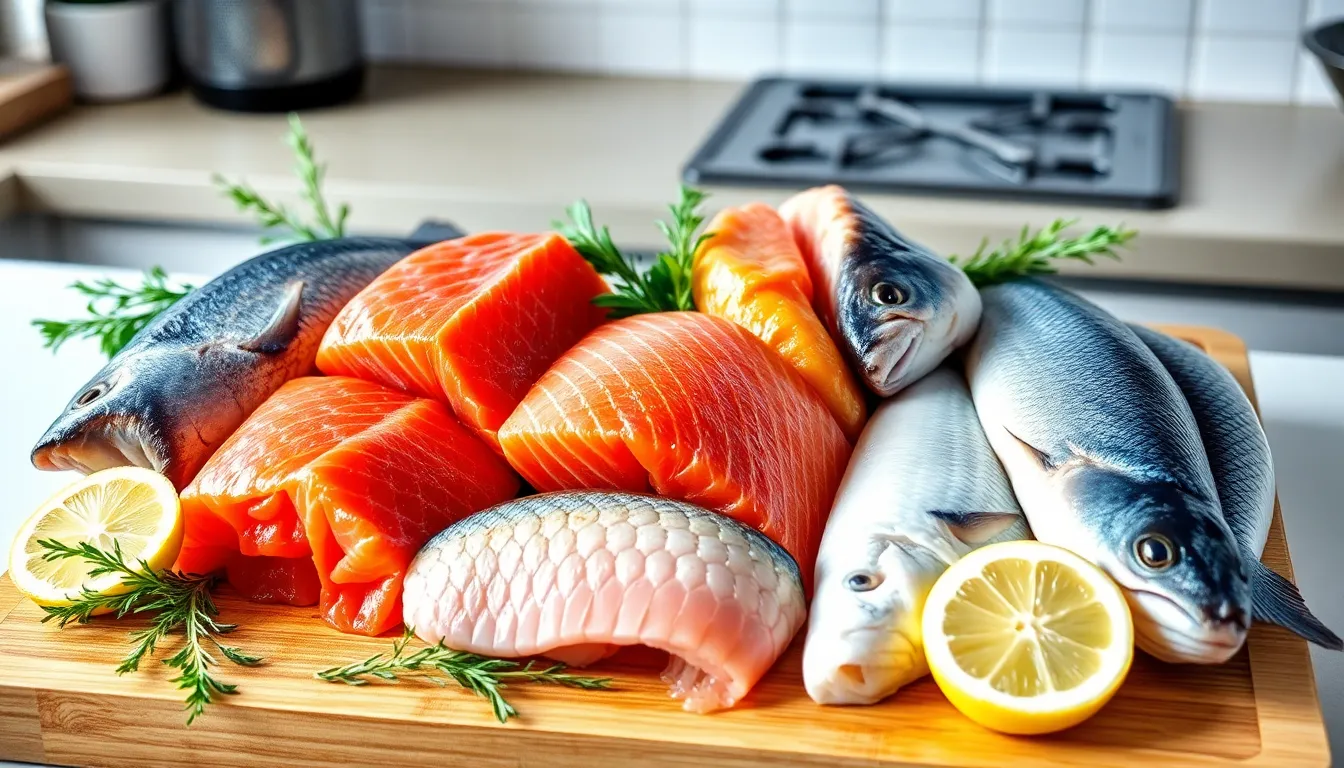When it comes to packing a protein punch, fish are the unsung heroes of the culinary world. Forget about those boring protein shakes that taste like chalk; the ocean’s bounty offers delicious options that not only satisfy your taste buds but also fuel your muscles. But which fish takes the crown for the most protein?
Table of Contents
ToggleOverview of Fish and Protein
Fish serve as an excellent source of protein, often outperforming traditional protein shakes. They vary in protein content, with certain species boasting higher levels than others. Salmon, for example, contains about 22 grams of protein per 3-ounce serving, making it both nutritious and flavorful.
Tuna is another high-protein option, featuring around 25 grams of protein in the same serving size. Moreover, cod offers approximately 20 grams of protein, which supports muscle growth and repair.
Fish like haddock and tilapia also rank favorably, with each providing around 20 grams of protein per serving. Nutritional value differs among types, with fatty fish delivering omega-3 fatty acids alongside their protein benefits.
Choosing fish as a protein source presents advantages beyond health. Many fish varieties are low in calories, making them suitable for various diets. Nutrient density makes fish not only a protein-rich food but also beneficial for overall health.
Incorporating fish into meals promotes a balanced intake of essential amino acids. Opting for fish contributes to sufficient protein consumption while avoiding excess fat associated with some animal proteins. Thus, selecting protein-rich fish varieties enhances dietary quality.
Top High-Protein Fish

Fish serve as an excellent source of protein, offering various options with high nutritional value. Several fish species stand out due to their impressive protein content.
Fish Species with the Highest Protein Content
Salmon and tuna consistently rank among the top options. Salmon provides about 22 grams of protein in a 3-ounce serving. Tuna leads with approximately 25 grams of protein, making it an ideal choice for protein enthusiasts. Cod and haddock also perform well, each delivering around 20 grams of protein per serving. Tilapia rounds out the list with similar protein levels, offering a versatile ingredient for various recipes.
Nutritional Comparison of Popular Fish
A nutritional comparison highlights different types of fish and their benefits. Salmon contains not only protein but also healthy omega-3 fatty acids. Tuna, in addition to its protein content, offers essential vitamins and minerals like vitamin D. Cod is lower in calories, with around 90 calories per serving, making it a lighter option. Haddock is comparable, providing around 20 grams of protein and similar calorie counts. Tilapia remains a popular choice for its mild flavor and approximately 20 grams of protein, making it an accessible option for many diets.
Health Benefits of Protein-Rich Fish
Protein-rich fish significantly contribute to a healthy diet due to their essential amino acids and nutrient density.
Role of Protein in a Balanced Diet
Protein serves as a fundamental building block for muscles, tissues, and organs. It also supports the body’s overall metabolic processes. Consuming adequate protein promotes muscle growth, repair, and maintenance, making it especially important for active individuals and those recovering from injuries. Fish provides a high-quality protein source that complements carbohydrates and fats in a balanced diet. Additionally, protein regulates appetite, helping to maintain satiety and control body weight. Regular intake of protein through fish sources aids in stable energy levels and supports muscle function throughout daily activities.
Additional Nutrients Found in High-Protein Fish
High-protein fish deliver numerous additional nutrients beyond just protein. Omega-3 fatty acids found in salmon and tuna contribute to heart health, reducing inflammation and lowering cholesterol levels. These health benefits are enhanced by the vitamins and minerals that accompany the protein, such as vitamin D, which supports calcium absorption and bone health. Notably, iodine present in various fish aids in thyroid function, while selenium acts as an antioxidant. Incorporating these fish into meals boosts nutrient diversity, thereby enhancing overall dietary quality and providing essential support for various bodily functions.
Cooking Methods to Retain Protein
Optimal cooking methods maximize protein retention in fish. Methods like grilling, baking, or steaming preserve essential nutrients effectively. Frying, however, tends to introduce extra fat and lower the overall protein concentration.
Best Practices for Cooking Fish
Starting with fresh fish enhances nutrient retention. Keeping skin on while cooking helps maintain moisture and flavor. Cooking at lower temperatures minimizes nutrient loss. Flipping the fish only once reduces stress and preserves texture. Use marination with lemon juice or herbs to enhance flavor without compromising protein content.
Recipes Featuring High-Protein Fish
Grilled salmon topped with fresh herbs offers a tasty high-protein meal. A simple tuna salad packed with diced vegetables makes for a nutritious lunch option. Baked cod with lemon and garlic delivers a light yet satisfying dinner choice. Stir-fried tilapia with colorful veggies provides both flavor and essential nutrients in one dish. Incorporating these recipes fosters a balanced diet while highlighting the benefits of high-protein fish dishes.
Choosing fish as a primary protein source offers numerous health benefits that extend beyond just muscle support. With options like salmon and tuna leading the way in protein content, individuals can enjoy flavorful meals while reaping the advantages of essential nutrients. Fish not only enhances dietary quality but also contributes to overall well-being through its rich supply of omega-3 fatty acids and vital vitamins.
Incorporating a variety of fish into meals promotes a balanced diet and supports various bodily functions. By opting for healthier cooking methods, one can maximize the nutritional value of fish dishes. Embracing these high-protein options can lead to improved health outcomes and a more enjoyable culinary experience.






